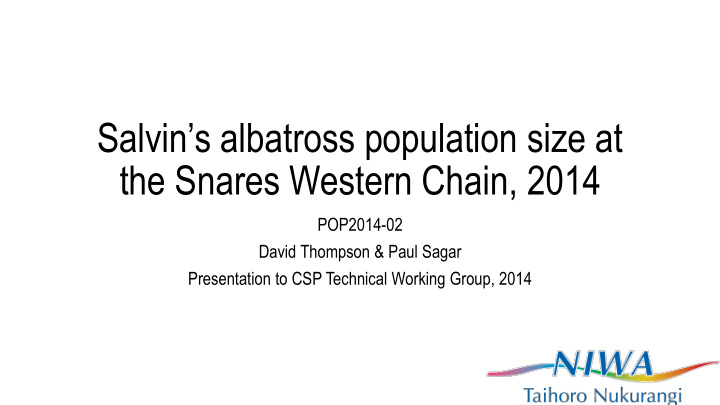



Salvin’s albatross population size at the Snares Western Chain, 2014 POP2014-02 David Thompson & Paul Sagar Presentation to CSP Technical Working Group, 2014
Salvin’s albatross population size at the Snares Western Chain, 2014 POP2014-02 – Salvin’s albatross, The Snares, 2014 Objectives: • The population size of Salvin’s albatross at the Snares Western Chain. • To ground truth an aerial survey. • To collect data on banded birds in order to estimate adult survival.
Salvin’s albatross – Thalassarche salvini • Endemic species – breeds mainly on Bounty Islands & Snares Western Chain • Annual breeder • At breeding colonies August-April • During the breeding season foraging extends primarily west to Australia and due south to about 60 o S • After breeding, most of the population migrates to the Humboldt Current off Peru and Chile, although some spend that time off eastern Tasmania • Recorded as bycatch in NZ trawl fisheries in relatively high numbers and identified as at potential risk from impacts of commercial fisheries
Background • At the Snares Western Chain Salvin’s albatrosses breed only on Toru and Rima Islets, plus one un- named offshore stack. • During 1977, 1984 and 1995 counts were made late in the egg stage or during the chick stage. These indicated a high mortality of eggs and chicks. • In the three years 2008-2010 counts of incubating birds during Sep-Oct resulted in totals of 1100- 1200 annually breeding pairs.
Methods – ground counts • Each islet was searched systematically for the presence of Salvin’s albatross nests containing an egg. • Salvin’s albatross nests were counted where an albatross (with or without a partner) was incubating an egg. In addition, counts were made of birds at empty nests and of broken/displaced eggs. • After counting, each nest was marked with a spot of stocker marker • To obtain an estimate of the number of nests missed or double counted, on completion of the count at least 100 albatross nests were checked and recorded as marked, unmarked or double marked. • The % of nests missed or double counted was used to give an adjusted total for each islet.
Methods – ground-truthing of aerial survey • In order to avoid disturbing birds during the aerial survey of Toru, ground-truthing was completed there immediately after the helicopter moved on to make the aerial survey of Rima. • Counts were made of birds on nests with eggs, birds on empty nests, and loafing birds along 2-m wide transects.
Methods – recaptures of banded birds • Each islet was systematically searched for the presence of birds banded during previous expeditions. • Particular attention was paid to the study area established on Toru Islet, where 234 breeding birds were banded during 2008-2010. • All banded birds recaptured were marked temporarily with stock marker so that they were not disturbed again during this trip. • The status of all recaptured birds was recorded as breeding (on an egg) or not breeding (on an empty nest or loafing in the colony).
Results – ground counts
Snares Western Chain ground counts, 17 September 2014 Ground count Transect count TOTAL Broken Bird on Bird on Adjusted nest + egg total Un-marked Marked nest + egg empty nest eggs Toru 804 52 74 1 115 811 Rima 301 37 14 0 100 301 Not Not Un-named islet 13 1 0 13 completed completed TOTAL 1118 88 1 215 1125
Snares Western Chain ground-truthing of aerial survey, 17 September 2014 Ground count Bird on Transect Bird on nest + egg empty Loafers nest 1 50 5 27 2 25 5 20 3 25 4 10 TOTAL 100 14 57
Band re-sighting, adult survival Month/Year banded Status at banding Number banded Number (% of total banded) recaptured Jan 1986 Chick 71 8 (11.3) Oct 1995 Breeding adult 123 10 (8.1) Oct 2008 Breeding adult 71 22 (31.0) Oct 2009 Breeding adult 40 14 (35.0) Sep 2010 Breeding adult 20 13 (65.0) Total 325 67 (20.6) Model combined all birds – 0.951 survival (0.754-0.992)
Conclusions • Total of 1,213 breeding pairs in September 2014 • 1,195 in October 2008 (or 1,229 if ‘abandoned’ clean eggs included) • 1,116 in September-October 2009 • 171 birds counted as part of ground-truthing • 58.5% breeding • 8.2% on empty nests • 33.3% loafing • Combined survival probability of birds banded as chicks in 1986 or as adults between 1995 and 2010 of 0.951 – high among annual albatross species
Acknowledgements 2014 fieldwork carried out by Paul Sagar and Matt Charteris, 2014 survival modelling by Paul Scofield. Thanks to Henk Haazen and the crew of Tiama for safe travel to, and from the Western Chain, and to DoC staff at Invercargill and Stewart Island for logistic support.
Recommend
More recommend